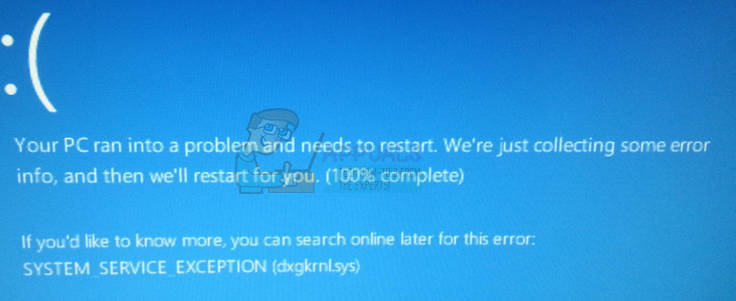FIX: SYSTEM_SERVICE_EXCEPTION (dxgkrnl.sys)
dxgkrnl.sys is Microsoft’s DirectX graphics kernel file. It works with your graphic card’s drivers, and as such, shouldn’t be modified in any way.
Getting a BSOD with this message, SYSTEM_SERVICE_EXCEPTION (dxgkrnl.sys) indicates that the graphic card and its drivers have malfunctioned in some way. However, it is a software issue, and an easy one to solve. Vulnerable users include, but are not limited to, people who use multiple GPUs in SLI, as well as people who use Nvidia Surround for working on multiple monitors. It usually appears with Windows 10 users, but users of older versions of Windows are not excluded.

There are a few things that you can do to solve this problem, and all of them are fairly easy to follow. You might want to read all of them, as they concern different user groups, so you should see which one you fit first, and apply the appropriate method.
Method 1: Disable SLI
Although this is more of a workaround than a method, if you’re on Nvidia’s version 353.62 and you use more than one graphics card, this is the only solution so far. Disabling SLI will cause you to suffer a performance hit when working with graphic intensive applications, or gaming, but it is the only solution for this version of Nvidia’s drivers.
To disable SLI, you will need to open Nvidia Control Panel, by right-clicking on your desktop and selecting it from the dropdown menu. To the left, you will see a navigation pane. Expand the 3D Settings option and choose Set SLI and PhysX configuration. Inside this menu, under SLI configuration, you should choose Disable SLI. Close the Nvidia Control Panel by clicking Apply, then OK afterwards.
This method is for users who for some reason can’t, or won’t update to newer drivers for their GPUs. This one in particular is known to cause a BSOD, especially with Windows 10. You can use the method to prevent BSODs until you can find a more permanent fix, such as a newer driver.
Method 2: Disable Nvidia Surround
Surround is Nvidia’s technology for people who want to run more than one display at a time, and it offers immersive gaming options that can truly enhance your experience. However, it is known to cause problems with Windows 10, and disabling it can stop those dreaded BSODs from appearing.
To disable it, right click on your desktop and open Nvidia Control Panel. Again, in the navigation pane to your left, expand 3D Settings and click on Configure Surround, PhysX. Under Surround configuration, you should uncheck Span displays with Surround. You can now close the Nvidia Control Panel by clicking Apply, then OK.
Method 3: Uninstall the Nvidia drivers, and let Windows install its own
Since this is after all a driver issue, one more possible solution is to uninstall the drivers you have installed, and let Windows install its own. Windows will find compatible drivers which shouldn’t be causing any issues with your computer, and you will be able to use it without worrying afterwards. The steps to doing this are fairly easy.
Open the Start menu, and search for Device Manager. Open the result, and you will see a list of devices connected to your computer. Expand Display Drivers and inside you will find your graphics card’s drivers. Right-click it, and choose Uninstall. Let the uninstall wizard do its thing, following the steps, and reboot your system. When you reboot, you can use Windows Update to download the latest drivers. Type Windows Update in the Start menu and open the result. Click on Check for Updates and Windows should see that no drivers are currently installed for your graphics card, which will make it look for appropriate ones on the Internet. Let it download and install them, and reboot your system again.
With Windows having installed drivers for your graphics card, your system should be up and running as it was prior to the errors. This is a method that works for a number of GPU driver issues, and it has been proven to work for this one as well.
The dxgkrnl.sys error is known to exist to both Nvidia and Microsoft. However, if you’d rather avoid waiting for them to issue a solution to it, you can follow the aforementioned steps and fix your device by yourself, so you can continue using it without fearing a Blue Screen of Death.
Method 4: Analyse DMP Files
If the methods above won’t resolve the issue for you, then click (here) to view the WinDBG guide so you can analyse the BSOD Dump Files yourself.